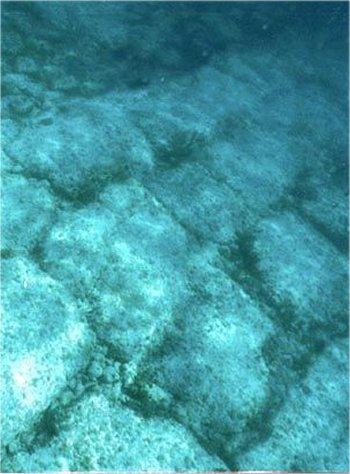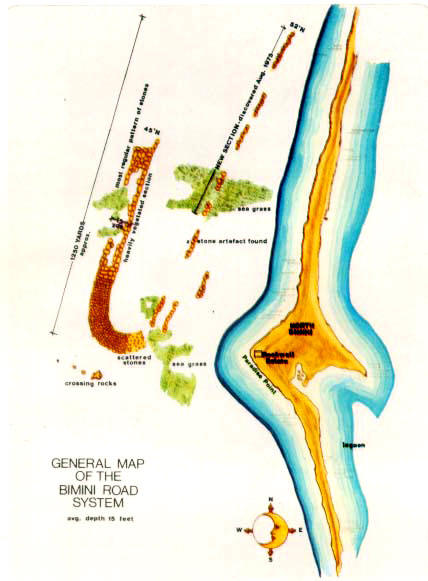| |
Unsolved Mysteries of World - Bimini Road |
|
Source: http://unmyst3.blogspot.com/2009/01/bimini-road.html
 |
|
Bimini is an island in the Bahamas, 55 miles east of Miami, Florida, approximately 7 miles long and 1/3 mile across at its widest point. Its modern inhabitants are descendants of West African slaves imported by Spain and Britain beginning in the mid-16th century. They replaced the resident Caribs, who arrived only a few generations before and after whom the Caribbean Sea was named. Bellicose cannibals from Middle America’s mainland, the Caribs feasted on the island’s earliest known inhabitants, the Lucayans, a linguistic branch of Arawak Indians. Before their extermination (consumption?), the Lucayans were described by Spanish explorers as able craftsmen (surviving Lucayan celts and hammer-stones attest to their refined skills), with noticeably lighter complexions and auburn hair, even occasional blue eyes. These untypical traits may have been genetic traces of contacts with pre-Columbian visitors from Europe, or even racial evidence for an Atlantis pedigree, in view of the following information. The origin and meaning of “Bimini” are unknown. However, the name appears in the Ancient Egyptian language as Baminini, which means, “Homage (ini) to the Soul (ba) of Min.” Min was the Egyptians’ divine protector of travelers on far-off journeys, a particularly appropriate god to be worshiped at distant Bimini, if indeed the island had been visited by voyagers from the Nile Valley. It is a popular spot for scuba divers and yachting enthusiasts.
Material evidence for an Egyptian or, at any rate, an Egyptian-like presence in the western Atlantic appeared during the late 1930s, when James Lockwood, Jr., an American archaeologist in Haiti, saw a stone statue of the ancient Egyptian god of the dead, Anubis, that had been discovered on an off-shore island. The Lucayans knew Bimini as “Guanahani,” another curious connection with the Ancient World, because the name translates as “the Island (hani) of Men (guana)” in the language of the Guanches. These were native inhabitants of the Canary Islands, off the northwest coast of North Africa, until their utter demise at the hands of the Spanish in the 15th and 16th centuries.
Although no monumental buildings were found on Bimini, in Arawak, Guanahani meant “the Place of the Encircling Walls”; in Arawak, hani was also synonymous for “crown” or “wreath.” This oldest known name for the island may have referred to a large stone formation lying in 19 feet of water less than 2 miles off Bimini’s northernmost point. It is composed of so far unnumbered but certainly no less than 5,000, mostly square-cut blocks running in a straight line for about 1,900 feet, before swinging back on itself to create a J-formation. To early observers, it resembled a paved road running across the bottom of the sea. But the general consensus of investigators since then tentatively identifies the structure as a cyclopean wall, not unlike Andean examples found in Peru, specifically, at Cuzco and Sacsahuaman.

Unfortunately, it continues to be known by its first and misleading appellation. In 1933, Edgar Cayce, during one of his trance states, said that records from Atlantis still existed “where a portion of the temples may yet be discovered, under the slime of ages of sea water—near what is known as Bimini.” The little island was not Atlantis itself, he explained, but its outpost, known many thousands of years ago as Alta, extending (politically) to east-coastal Florida, and part of a wider Atlantean administration known as Poseidia, comprising the Lesser Antilles. In 1940, the “Sleeping Prophet” predicted, “Poseidia will be among the first portion of Atlantis to rise again. Expect it in ’68 and ’69; not so far away!” The so-called “Bimini Road” was, in fact, “discovered” in 1968 by maverick archaeologist Mason Valentine, while looking for Atlantean remains around the island in hopes of confirming Cayce’s prophesy.
Since then, the underwater site has been subjected to continuous investigation by researchers convinced it is an Atlantean ruin and critics sure it is nothing more than a natural formation of beach rock. The latter, despite their standard array of academic credentials, have for more than 30 years failed to show an analogous arrangement of beach rock, not only at Bimini, but anywhere else in the world. Allegedly similar examples from Loggerhead Key, Dry Tortugas, or near Sri Lanka, cited as evidence for its entirely natural provenance, are so unlike the linear, organized blocks found at Bimini that such comparisons are worthless. Moreover, core-drillings at the Bimini Road, beginning in the mid-1980s, extracted micrite, which does not occur in beach rock. Some of its stones contain conglomerations of aragonite and calcite, patterns likewise missing from beach rock. Florida geologist, Eugene A. Shinn, a harsh critic of theories on behalf of the Bimini structure’s artificiality, radio-carbon dated the stones, which range in age from 2,000 to 4,000 years before present.
The oldest end of this time parameter coincides with the Middle Bronze Age, just when port facilities resembling the Bimini site were being constructed in the Near East, and Atlantis was nearing the apogee of its material greatness, according to researchers who argue that Plato’s sunken city flourished from 3000 to 1200 B.C. Serious investigation of the Bahama site began in the late 1960s under the direction of Valentine and his scientific colleague, Dimitri Rebikoff, continuing into the 1970s and early 80s through the work of Dr. David Zink, whose Stones of Atlantis was the first full-length book published on the subject. During the 1990s and early years of the 21st century, numerous underwater expeditions to Bimini conducted by William Donato, president of The Atlantis Organization (Buena Park, California), have contributed significantly toward a general appreciation of the structure’s real identity.
The underwater ruin appears to be the foundation of a continuous rampart which originally formed an elongated oval (the Lucayans’ “Encircling Wall”?) to shelter seagoing vessels. A harbor at the north end of Bimini makes abundant maritime sense, because its location serves two fundamentally important prerequisites for transoceanic travel: First, the island stands directly in the path of an Atlantic current that travels like an underwater conveyor belt—northward, parallel to New England shores, then due east toward the Azores, the British Isles, and Western Europe. Second, Bimini is the last landfall for fresh water before a transatlantic voyage from North America. The discovery at Bimini of additional, prehistoric evidence underscores the site’s ancient, man-made identity.
These include colossal effigy mounds shaped like fish and other zoomorphic and geometric figures, together with additional blocks also found at 19-foot depths, about 3 miles northeast of the road, resembling Tiahuanaco’s squared columns in the high Andes of Bolivia. But what divers see at Bimini today are the ruins of a ruin. As recently as the early years of the 20th century, the surface of the Road was visible at low tide, when its location was even designated “a navigational hazard.”
Older natives still living in the 1990s personally testified they saw waves washing over the tops of the stones on numerous occasions when they were young, although most inhabitants of the island avoided the site with superstitious dread. In the early 1920s, a Florida salvage company dismantled the structure down to its bottom course. The blocks were removed to Miami, where they were used as fill for the city’s new quayside. Cayce may in fact have described the Bimini Road as early as 1932. He said in a reading for May 5: This we find (at Poseidia) not an altogether walled city, but a portion of same built so that the waters of these rivers became as the pools about which both sacrifice and sport, and those necessities for the cleansing of the body, home and all, were obtained, and these—kept constantly in motion so that it purified itself in its course;—water in motion over stone—purifies itself in twenty feet of space.
The base of the Bimini Road is 1 foot short of 20 feet underwater. Rivers do not exist on the island today, but they did in its geologic past. Cayce seems to have portrayed the Road, not as part of a harbor, but a ritual and recreational feature. Ongoing investigations at Bimini with increasingly sophisticated search technology may prove that “the Place of the Encircling Walls” was indeed Cayce’s Alta, where ships 3,000 years ago, heavy-laden with copper ore mined in North America, replenished their provisions of fresh water on the last leg of their return voyages to Atlantis.
Submit News/Videos/Links |
Discuss article |
Article Link
|
More unsolved mysteries on Unexplained Mysteries
|


